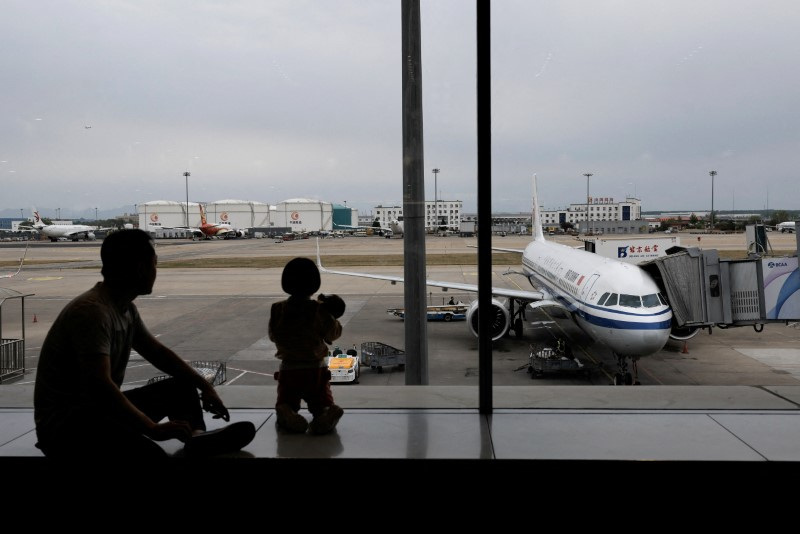By Lisa Barrington
SEOUL (Reuters) – Chinese airlines are gaining market share on international routes, industry data shows, as foreign rivals are deterred by weak Chinese travel demand and rising costs and longer flight times due to the need to avoid Russian airspace.
Foreign airlines, led by Western carriers such as British Airways and Australia’s Qantas Airways, are withdrawing services or choosing not to restart flights to China after the pandemic, while Chinese airlines are expanding their overseas operations.
The share of international flights to and from China operated by the country’s airlines is higher than before COVID-19 grounded much of global aviation, and continues to rise.
British Airways said on Thursday it would suspend flights from London to Beijing for a year from the end of October for commercial reasons and last month suspended one of its twice-daily London-Hong Kong flights for the same period.
Since the outbreak of war in Ukraine in 2022, Chinese airlines have continued to take shorter northern routes to Europe and North America over vast Russian airspace.
Airlines in Europe, the US and other countries, on the other hand, have been banned from Russian airspace by Moscow or their own governments, or have chosen not to fly over for safety reasons.
That has boosted Chinese airlines’ cost advantage and allowed them to capture a bigger share of the international market at a time when fierce competition on domestic routes has put pressure on ticket prices and profitability.
“Typically, Chinese airlines have up to 30% lower costs than their international rivals,” said John Grant, senior analyst at travel data firm OAG. “Chinese airlines are desperate for hard currency and have embarked on a large-scale expansion.”
According to flight tracker Flightradar24, British Airways’ four-day flight between Beijing and London takes about 2.5 hours longer than China Southern’s daily flight on the same route launched last year.
British Airways will continue daily flights between London and Shanghai and relaunched a codeshare with China Southern in May.
Virgin Atlantic said last month it would suspend its London-Shanghai service indefinitely from the end of October due to longer flight times.
British Airways and Virgin Atlantic will be able to use London Heathrow’s valuable take-off and landing slots for other routes that may be more profitable.
Qantas cited half-empty planes and low demand for travel to China when it suspended Sydney-Shanghai flights in July, while Asian carrier Royal Brunei Airlines pointed to “market conditions” as the reason for suspending twice-weekly flights to Beijing from October.
WITHDRAWAL FOREIGN CARRIERS
Chinese airlines, including China Southern, China Eastern and Air China (OTC :), operated 90% of the number of international flights they operated in July 2019, according to Cirium schedule data analyzed by Reuters.
Foreign airlines operated only 60% of flights before the pandemic, signaling a retreat.
For example, the only nonstop flights between Mexico and China are on Chinese airlines after Aeromexico failed to resume connections after the pandemic. Aeromexico did not respond to a request for comment.
Lufthansa CEO Carsten Spohr said last week that the group’s weakness in Asia does not stem from a lack of economic opportunities, but from “the overcapacity of Chinese airlines.”
But in the Middle East, where China has built ties, Dubai’s Emirates has fully restored capacity to China, Kuwait Airways has increased frequencies and Bahrain’s Gulf Air started flights to two Chinese cities for the first time in May.
International travel in China has grown since pandemic restrictions were lifted in early 2023, but is recovering more slowly than in other countries due to a faltering economy and a turn to domestic travel.
There were 23% fewer flights from China in July than in the same month in 2019, Cirium data shows.
POLITICAL ISSUES
Some flights to and from China are held up by political issues. Passenger flights between India and China did not resume at all after the pandemic due to a border dispute.
Flights between China and the United States are at about a fifth of 2019 levels after a bilateral air services agreement was suspended in 2020.
Reciprocal flight authorizations have gradually increased, but US airlines are operating only 35 round trips per week out of 50 allowed, Cirium data shows, while Chinese airlines have increased this number to 49 per week.
United Airlines said last month it had reallocated capacity to other parts of the Asia-Pacific region due to “dramatically” lower demand for travel to China.

Major U.S. airlines and aviation unions asked the U.S. government in April to stop approving flights from Chinese airlines in a letter citing Beijing’s “anti-competitive policies” and the disadvantage of overflying Russia.
“If the growth of China’s aviation market is allowed to continue unchecked… flights will be transferred to Chinese airlines,” the letter said.


